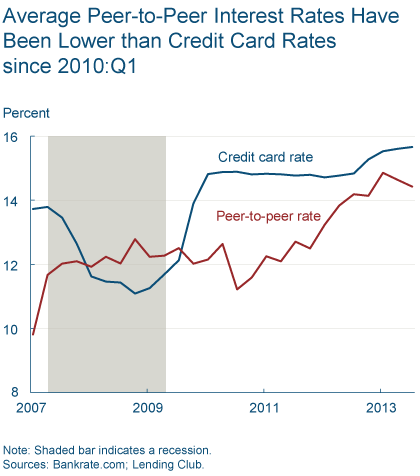Yesterday, two major reports were published on the p2p lending industry. First, the Federal Reserve Bank of Cleveland put out a positive report on the future potential growth of this industry and the same day Fitch Ratings published a more sobering report on where the p2p lending industry stands today. Both make for some very interesting reading.
First let’s take a look at the report from the Cleveland Fed. This is a quick read containing some very interesting graphs. It is focused on interest rates, particularly their comparison with average credit cards rates. I found the chart below interesting.
So, on average credit card interest rates have been significantly higher than the average rates at Lending Club. It appears that the Cleveland Fed did not use data from Prosper in their analysis. What is even more interesting is the fact that peer to peer loans have been performing slightly better than credit cards when it comes to the percentage that are delinquent.
On average, between 2010:Q2 and 2014:Q1, 3.2 percent of peer-to-peer loans were past due compared to 3.7 percent of standard consumer finance loans. Over this period, peer-to-peer loans had a lower share of poorly performing loans in 10 of 16 quarters.
The conclusion of the report is that p2p lending will continue to grow because borrowers find it an attractive alternative to credit cards and there is strong investor demand.
There are three major credit ratings agencies in the US: Standard & Poors, Moodys, and Fitch Ratings. These businesses are very important to the financial system because institutional investors use these ratings to make investment decisions. They rate the credit worthiness of debt issued by corporations and governments as well as asset backed securities.
Last month Standard & Poors rated a securitization by SoFi and that was very big news for this industry. Yesterday, Fitch Ratings released a report on peer to peer lending – this follows on from the Standard & Poors coverage from a couple of months ago. That major ratings agencies are starting to take notice.
I was able to obtain a copy of the Fitch report and it makes for some interesting reading – unfortunately the full report is not available publicly. It is helpful for those of us, like myself, who are sanguine about the industry’s future to stop and see how some impartial financial analysts view p2p lending. While the message comes through that Fitch believes the industry does indeed have great potential they do not have enough confidence yet that it will realize this potential.
Here is a summary of their concerns:
- Platforms have limited operating history – no company has been around long enough to have weathered multiple economic cycles.
- Rising interest rates could have an adverse impact – both investor and borrower demand could reduce in a rising interest rate environment.
- Regulatory risk remains elevated – they take the view regulations could change – in fact they believe that p2p lenders should be mandated to retain a portion of their loan book.
For these reasons Fitch states that any rating for this debt will be below investment grade and even then they would only consider a debt rating from one of the major platforms. This makes the “A” rating that SoFi received from S&P last month all the more impressive.
Many investors have the same concerns that Fitch has. These are all valid concerns that I hear regularly and they are part of the reason why many people still view this industry with skepticism. The way I look at it is this. As investors we are being compensated very well for risking our investment in this asset class. For me, the three concerns above are not enough to dissuade me from investing. But it is a good reminder that this asset class is still relatively new and it is not without risk.



